Mitigating Container Damage and Enhancing Operational Efficiency in Global Containerisation
Abstract
Highlights:
- What are the main findings?
- We introduce the Impact Detection Methodology (IDM), a system to monitor and detect crane-induced impacts on containers in real time, demonstrating effectiveness in mitigating handling-related damage.
- We identify key factors contributing to container damage, such as unsuccessful hooking attempts during above-deck lifts due to spreader oscillations and high operational workloads.
- What is the implication of the main findings?
- Integrating the IDM with crane management technologies and sway control systems can enhance operational precision, reduce container damage, and improve port efficiency.
- Broader real-time monitoring and advanced analytics adoption can support sustainable growth in global containerisation by reducing operational costs and mitigating financial risks.
Abstract
1. Introduction

2. Materials and Methods
- The model was “Steval–Mki109V3”.
- The data acquisition rate was 100 Hz.
- We worked in low-power mode.
- The acceleration detection was ±16 g.
- When the crane lowers the spreader onto a container for lifting, an impact occurs as the spreader meets the container.
- If properly aligned, the spreader’s four hooks match the container’s slots, creating a slight and expected vibration on contact—a normal and acceptable impact.
- This controlled impact allows the hooks to secure the container, ensuring a safe lift without further impact on non-reinforced areas.
- However, operator error or external factors can cause the hooks to strike non-reinforced areas, resulting in unacceptable impacts and potential container damage.
- Such misalignment disrupts the loading process, risks structural damage, and extends loading times due to the need for re-hooking attempts.
3. Results
4. Conclusions
Author Contributions
Funding
Institutional Review Board Statement
Informed Consent Statement
Data Availability Statement
Conflicts of Interest
References
- Xu, Y.; Peng, P.; Lu, F.; Claramunt, C. Uncovering the Multiplex Network of Global Container Shipping: Insights from Shipping Companies. J. Transp. Geogr. 2024, 120, 103991. [Google Scholar] [CrossRef]
- Yap, W.Y.; Yang, D. Geopolitical Tension and Shipping Network Disruption: Analysis of the Red Sea Crisis on Container Port Calls. J. Transp. Geogr. 2024, 121, 104004. [Google Scholar] [CrossRef]
- Review of Maritime Transport 2021; United Nations: New York, NY, USA, 2023.
- Zhou, G.; Li, D.; Bian, J.; Zhang, Y. Airfreight Forwarder’s Shipment Planning: Shipment Consolidation and Containerization. Comput. Oper. Res. 2024, 161, 106443. [Google Scholar] [CrossRef]
- Brooks, L.; Gendron-Carrier, N.; Rua, G. The Local Impact of Containerization. J. Urban. Econ. 2021, 126, 103388. [Google Scholar] [CrossRef]
- Feng, X.; Song, R.; Yin, W.; Yin, X.; Zhang, R. Multimodal Transportation Network with Cargo Containerization Technology: Advantages and Challenges. Transp. Policy 2023, 132, 128–143. [Google Scholar] [CrossRef]
- Huang, Z.; He, Z.; Zhao, P.; Zhang, C.; Niu, Y.; Guo, W.; Cui, Y.; Shao, W. The Effects of Tropical Cyclone on the Container Shipping Network: A Case Study of Typhoon Ma-on (2022). Transp. Res. D Transp. Environ. 2024, 136, 104449. [Google Scholar] [CrossRef]
- Lin, N.; Hjelle, H.M.; Bergqvist, R. The Impact of an Upstream Buyer Consolidation and Downstream Intermodal Rail-Based Solution on Logistics Cost in the China-Europe Container Trades. Case Stud. Transp. Policy 2020, 8, 1073–1086. [Google Scholar] [CrossRef]
- Achurra-Gonzalez, P.E.; Novati, M.; Foulser-Piggott, R.; Graham, D.J.; Bowman, G.; Bell, M.G.H.; Angeloudis, P. Modelling the Impact of Liner Shipping Network Perturbations on Container Cargo Routing: Southeast Asia to Europe Application. Accid. Anal. Prev. 2019, 123, 399–410. [Google Scholar] [CrossRef]
- Nguyen, P.N.; Kim, H.; Son, Y.M. Challenges and Opportunities for Southeast Asia’s Container Ports throughout the COVID-19 Pandemic. Res. Transp. Bus. Manag. 2024, 52, 101074. [Google Scholar] [CrossRef]
- Kugler, M.; Brandenburg, M.; Limant, S. Automizing the Manual Link in Maritime Supply Chains? An Analysis of Twistlock Handling Automation in Container Terminals. Marit. Transp. Res. 2021, 2, 100017. [Google Scholar] [CrossRef]
- Nexxiot. White Paper—Smart Containers. Safe, Secure and Compliant Supply Chains. Available online: https://nexxiot.com/resources/smart-containers-safe-secure-compliant-supply-chains/ (accessed on 12 December 2024).
- Martín-Soberón, A.M.; Monfort, A.; Sapiña, R.; Monterde, N.; Calduch, D. Automation in Port Container Terminals. Procedia Soc. Behav. Sci. 2014, 160, 195–204. [Google Scholar] [CrossRef]
- Götting, H.H. Automation and Steering of Vehicles in Ports. Port. Technol. Int. 2000, 10, 101–111. [Google Scholar]
- Hu, S.; Fang, Y.; Bai, Y. Automation and Optimization in Crane Lift Planning: A Critical Review. Adv. Eng. Inform. 2021, 49, 101346. [Google Scholar] [CrossRef]
- Tran, N.K.; Lam, J.S.L. Effects of Container Ship Speed on CO2 Emission, Cargo Lead Time and Supply Chain Costs. Res. Transp. Bus. Manag. 2022, 43, 100723. [Google Scholar] [CrossRef]
- The Port of Los Angeles. Available online: https://www.portoflosangeles.org/ (accessed on 4 November 2024).
- Sun, H.; Vanajakumari, M.; Sriskandarajah, C.; Kumar, S. Supply Chain Planning with Free Trade Zone and Uncertain Demand. Transp. Res. E Logist. Transp. Rev. 2024, 192, 103771. [Google Scholar] [CrossRef]
- Maritime and Logistics Profile of Latin America and the Caribbean. ECLAC. United Nations. Available online: https://perfil.cepal.org/l/en/portmovements_classic.html (accessed on 4 November 2024).
- Barleta, E.P.; Pallis, A.A. Hierarchy and Mobility of Latin America and Caribbean Container Ports. J. Transp. Geogr. 2024, 121, 104011. [Google Scholar] [CrossRef]
- Kim, H.-T. Prospect of Premier Port Competition in East Asian Region. Asian J. Shipp. Logist. 2011, 27, 191–215. [Google Scholar] [CrossRef]
- Styliadis, T.; Chlomoudis, C. Analyzing the Evolution of Concentration within Containerized Transport Chains through a Circuitist Approach: The Role of Innovations in Accelerating the Circuits of Liner and Container Terminal Operators. Asian J. Shipp. Logist. 2021, 37, 321–328. [Google Scholar] [CrossRef]
- The Shanghai International Port Group’s Annual Report for 2022; Shanghai Stock Exchange: Shanghai, China, 2022.
- Pomfret, R. The Eurasian Landbridge: Implications of Linking East Asia and Europe by Rail. Res. Glob. 2021, 3, 100046. [Google Scholar] [CrossRef]
- Listan Bernal, M.; Choi, Y.S.; Lee, H.C.; Kim, Y.N.; Yeo, G.T. An Analysis of Research Trends of the Asian Journal of Shipping and Logistics. Asian J. Shipp. Logist. 2024, 40, 139–146. [Google Scholar] [CrossRef]
- Platitas, R.J.C.; Ocampo, J.C.G. From Bottlenecks to Inflation: Impact of Global Supply-Chain Disruptions on Inflation in Select Asian Economies. Lat. Am. J. Cent. Bank. 2024, 6, 100141. [Google Scholar] [CrossRef]
- Nguyen, P.N.; Kim, H. The Effects of the COVID-19 Pandemic on Connectivity, Operational Efficiency, and Resilience of Major Container Ports in Southeast Asia. J. Transp. Geogr. 2024, 116, 103835. [Google Scholar] [CrossRef]
- Zhou, C.; Zhu, S.; Bell, M.G.H.; Lee, L.H.; Chew, E.P. Emerging Technology and Management Research in the Container Terminals: Trends and the COVID-19 Pandemic Impacts. Ocean Coast. Manag. 2022, 230, 106318. [Google Scholar] [CrossRef] [PubMed]
- Široka, M.; Piličić, S.; Milošević, T.; Lacalle, I.; Traven, L. A Novel Approach for Assessing the Ports’ Environmental Impacts in Real Time–The IoT Based Port Environmental Index. Ecol. Indic. 2021, 120, 106949. [Google Scholar] [CrossRef]
- Rødseth, K.L. Noise Pollution of Container Handling: External and Abatement Costs and Environmental Efficiency. Transp. Policy 2023, 134, 82–93. [Google Scholar] [CrossRef]
- Geerlings, H.; Van Duin, R. A New Method for Assessing CO2-Emissions from Container Terminals: A Promising Approach Applied in Rotterdam. J. Clean. Prod. 2011, 19, 657–666. [Google Scholar] [CrossRef]
- Yu, H.; Ge, Y.E.; Chen, J.; Luo, L.; Tan, C.; Liu, D. CO2 Emission Evaluation of Yard Tractors during Loading at Container Terminals. Transp. Res. D Transp. Environ. 2017, 53, 17–36. [Google Scholar] [CrossRef]
- Liu, D.; Ge, Y.E. Modeling Assignment of Quay Cranes Using Queueing Theory for Minimizing CO2 Emission at a Container Terminal. Transp. Res. D Transp. Environ. 2018, 61, 140–151. [Google Scholar] [CrossRef]
- Martínez-Moya, J.; Vazquez-Paja, B.; Gimenez Maldonado, J.A. Energy Efficiency and CO2 Emissions of Port Container Terminal Equipment: Evidence from the Port of Valencia. Energy Policy 2019, 131, 312–319. [Google Scholar] [CrossRef]
- 2023 IMO Strategy on Reduction of GHG Emissions from Ships; International Maritime Organization: London, UK, 2023.
- Mechai, N.; Wicaksono, H. Causal Inference in Supply Chain Management: How Does Ever Given Accident at the Suez Canal Affect the Prices of Shipping Containers? Procedia Comput. Sci. 2024, 232, 3173–3182. [Google Scholar]
- Benamara, H. Role of International Shipping. In Proceedings of the UNCTAD Multilayer Expert Meeting on Transport, Trade Logistics and Trade Facilitation, Geneva, Switzerland, 21–23 November 2018; 2018. 13p. [Google Scholar]
- The United Nations Centre for Trade Facilitation and Electronic Business (UN/CEFACT). White Paper—Smart Containers. Real-Time Smart Container Data for Supply Chain Excellence. Simple, Transparent and Effective Processes for Global Commerce. Available online: https://uncefact.unece.org/download/attachments/25919837/Background%20WP%20on%20Smart%20Containers.pdf?version=1&modificationDate=1562188423411&api=v2 (accessed on 12 December 2024).
- Bukkapatnam, S.T.S.; Komanduri, R. Container Integrity and Condition Monitoring Using RF Vibration Sensor Tags. In Proceedings of the 2007 IEEE International Conference on Automation Science and Engineering, Scottsdale, AZ, USA, 22–25 September 2007; pp. 585–590. [Google Scholar] [CrossRef]
- Hoffmann, N.; Stahlbock, R.; Voß, S. A Decision Model on the Repair and Maintenance of Shipping Containers. J. Shipp. Trade 2020, 5, 22. [Google Scholar] [CrossRef]
- Wang, K.; Ming, Y.; Wang, H.; Liu, X.; Qian, X.; Shi, T. Failure Analysis and Correction Models for Upward Flame Characteristics Subjected to Shipping Container Fire. Eng. Fail. Anal. 2023, 152, 107519. [Google Scholar] [CrossRef]
- World Shipping Council. Containers Lost at Sea 2022 Report; World Shipping Council: Washington, DC, USA, 2022. [Google Scholar]
- The Shanghai International Port Group’s Annual Report for 2021; Shanghai Stock Exchange: Shanghai, China, 2021.
- Wu, W.; Liu, Z.; Chen, M.; Yang, X.; He, X. An Automated Vision System for Container-Code Recognition. Expert. Syst. Appl. 2012, 39, 2842–2855. [Google Scholar] [CrossRef]
- Varagul, J.; Ito, T. Simulation of Detecting Function Object for AGV Using Computer Vision with Neural Network. Procedia Comput. Sci. 2016, 96, 159–168. [Google Scholar] [CrossRef]
- Mi, C.; HUANG, Y.; Liu, H.; Yang, S.; Mi, W. Study on Target Detection & Recognition Using Laser 3D Vision Systems for Automatic Ship Loader. Sens. Transducers 2013, 158, 436–442. [Google Scholar]
- Kalaimagal, S.; Sivaramakrishnan, R. Navigation of Autonomous Ground Vehicle Using Gps System. Int. J. Eng. Res. Technol. 2012, 1, 1–6. [Google Scholar]
- Joerger, M.; Christ, J.; Duncan, R.; Pervan, B. Integrated Design of an AGV for Improved GPS-Based Path-Following Performance. Int. J. Veh. Des. 2006, 42, 263–286. [Google Scholar]
- Wu, H.; Yin, Y.; Wang, S.; Shi, W.; Clarke, K.C.; Miao, Z. Optimizing GPS-Guidance Transit Route for Cable Crane Collision Avoidance Using Artificial Immune Algorithm. GPS Solut. 2017, 21, 823–834. [Google Scholar] [CrossRef]
- Sano, H.; Ohishi, K.; Kaneko, T.; Mine, H. Anti-Sway Crane Control Based on Dual State Observer with Sensor-Delay Correction. In Proceedings of the International Workshop on Advanced Motion Control, AMC, Nagaoka, Japan, 21–24 March 2010; pp. 679–684. [Google Scholar] [CrossRef]
- Wang, L.; Kwok, S.K.; Ip, W.H. A Radio Frequency Identification and Sensor-Based System for the Transportation of Food. J. Food Eng. 2010, 101, 120–129. [Google Scholar] [CrossRef]
- Potyrailo, R.; Nagraj, N.; Surman, C.; Boudries, H.; Lai, H.; Slocik, J.M.; Kelley-Loughnane, N.; Naik, R.R. Wireless Sensors and Sensor Networks for Homeland Security Applications. TrAC Trends Anal. Chem. 2012, 40, 133–145. [Google Scholar] [CrossRef]
- Abbate, S.; Avvenuti, M.; Corsini, P.; Vecchio, A. Localization of Shipping Containers in Ports and Terminals Using Wireless Sensor Networks. In Proceedings of the 2009 International Conference on Computational Science and Engineering, Vancouver, BC, Canada, 29–31 August 2009; pp. 587–592. [Google Scholar] [CrossRef]
- Jin, X.; Duan, Z.; Song, W.; Li, Q. Container Stacking Optimization Based on Deep Reinforcement Learning. Eng. Appl. Artif. Intell. 2023, 123, 106508. [Google Scholar] [CrossRef]
- Lu, Y.; Le, M. The Integrated Optimization of Container Terminal Scheduling with Uncertain Factors. Comput. Ind. Eng. 2014, 75, 209–216. [Google Scholar] [CrossRef]
- Rashidi, H.; Tsang, E.P.K. Novel Constraints Satisfaction Models for Optimization Problems in Container Terminals. Appl. Math. Model. 2012, 37, 3601–3634. [Google Scholar] [CrossRef]
- Cha, S.-H.; Noh, C.-K. A Case Study of Automation Management System of Damaged Container in the Port Gate. J. Navig. Port Res. 2017, 41, 119–126. [Google Scholar] [CrossRef]
- Camarero Orive, A.; Santiago, J.I.P.; Corral, M.M.E.I.; González-Cancelas, N. Strategic Analysis of the Automation of Container Port Terminals through BOT (Business Observation Tool). Logistics 2020, 4, 3. [Google Scholar] [CrossRef]
- Heilig, L.; Stahlbock, R.; Voß, S. From Digitalization to Data-Driven Decision Making in Container Terminals; Springer: Cham, Switzerland, 2019. [Google Scholar]
- Jakovlev, S.; Eglynas, T.; Voznak, M.; Jusis, M.; Partila, P.; Tovarek, J.; Jankunas, V. Detection of Physical Impacts of Shipping Containers during Handling Operations Using the Impact Detection Methodology. J. Mar. Sci. Eng. 2022, 10, 1250. [Google Scholar] [CrossRef]
- Jakovlev, S.; Eglynas, T.; Jusis, M.; Voznak, M.; Partila, P.; Tovarek, J. Detecting Physical Impacts to the Corners of Shipping Containers during Handling Operations Performed by Quay Cranes. J. Mar. Sci. Eng. 2023, 11, 794. [Google Scholar] [CrossRef]
- Jakovlev, S.; Eglynas, T.; Voznak, M. Application of Neural Network Predictive Control Methods to Solve the Shipping Container Sway Control Problem in Quay Cranes. IEEE Access 2021, 9, 78253–78265. [Google Scholar]
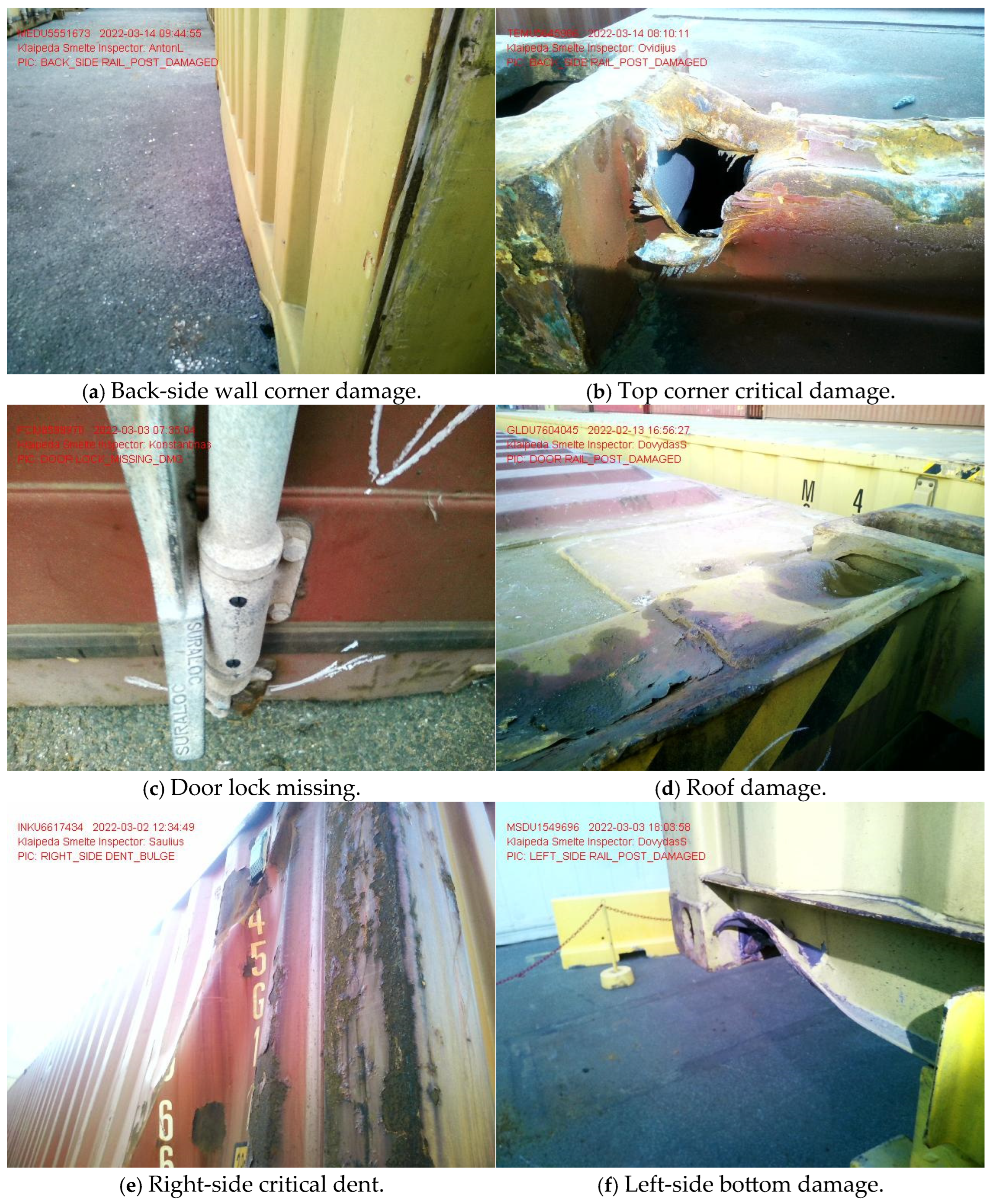
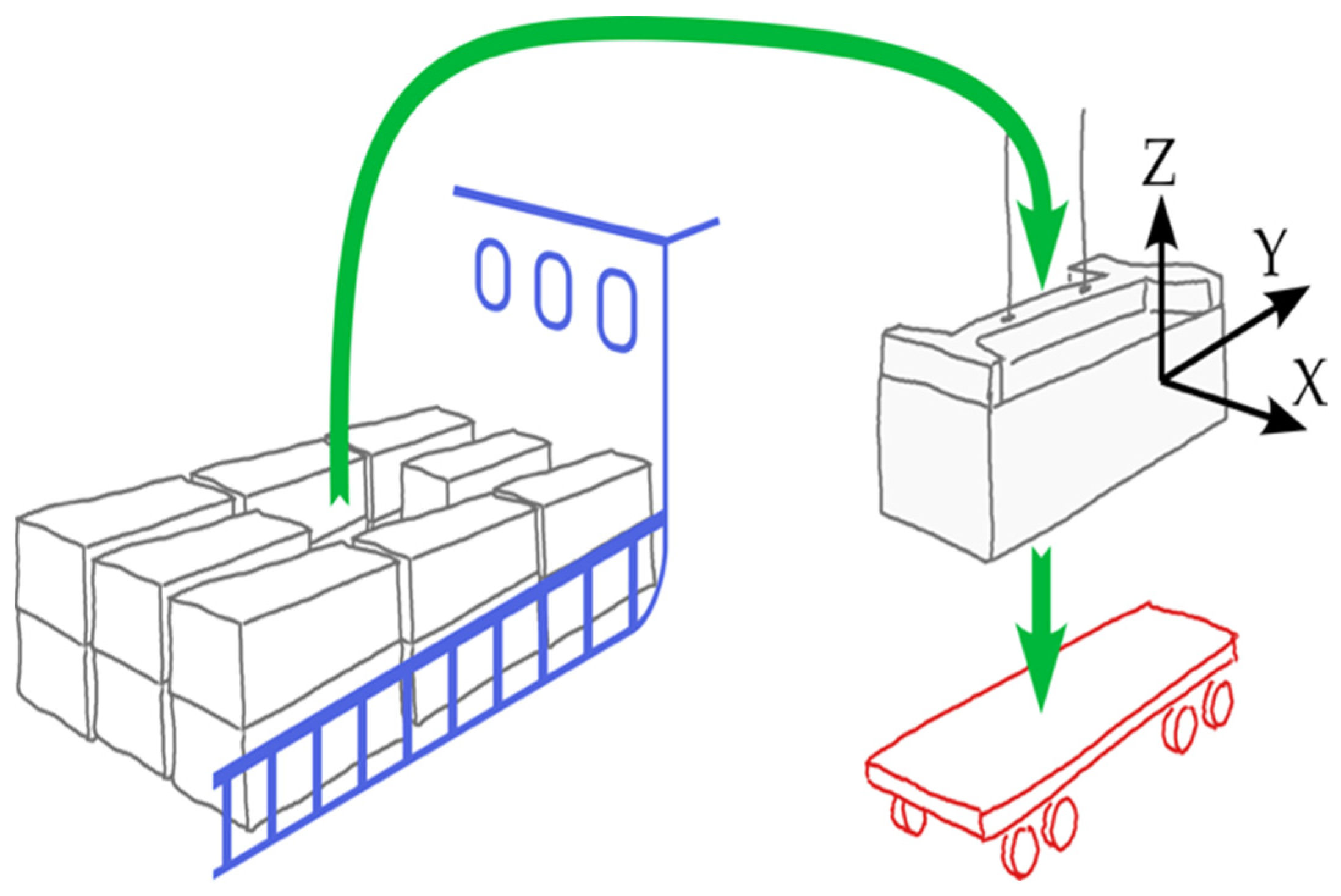



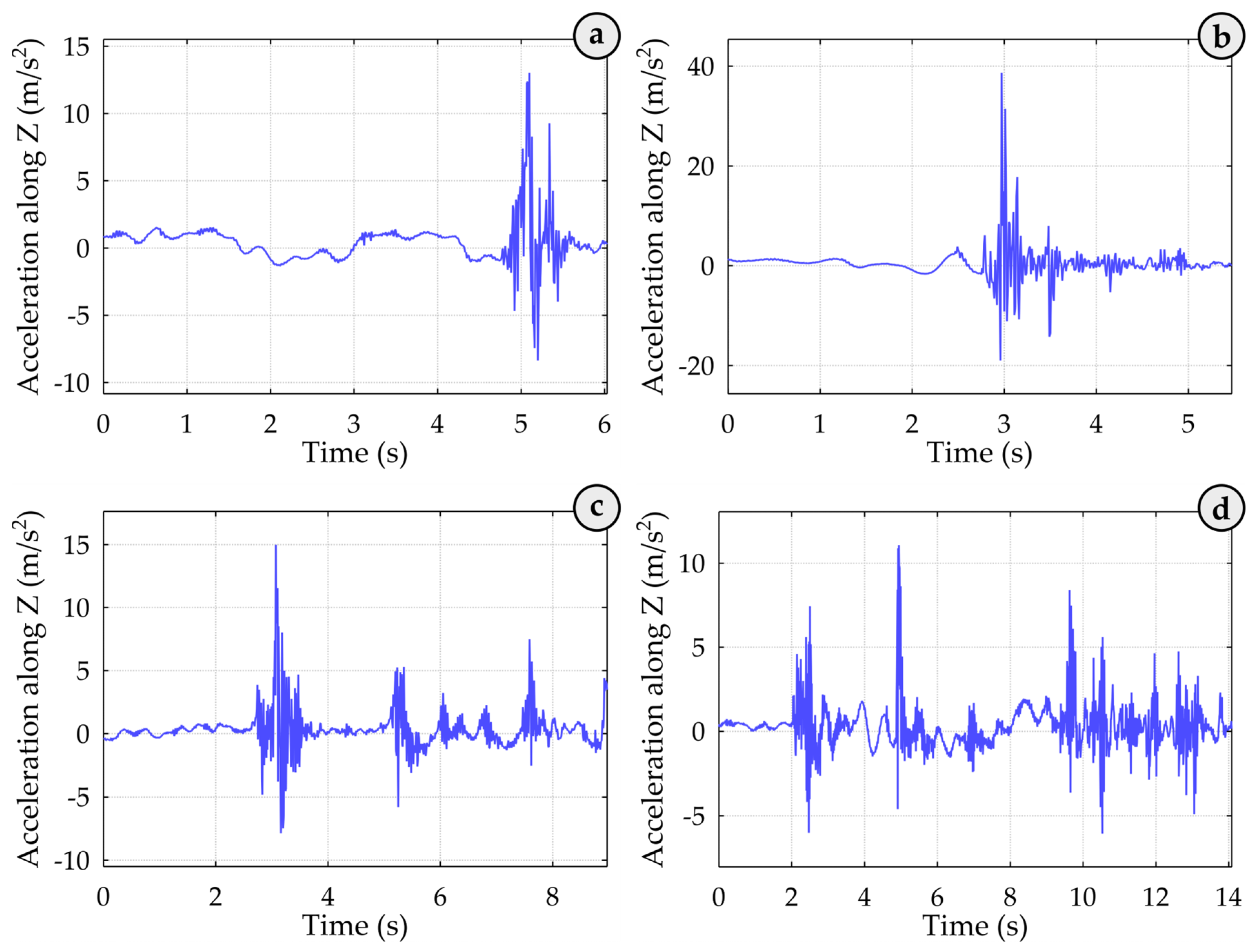
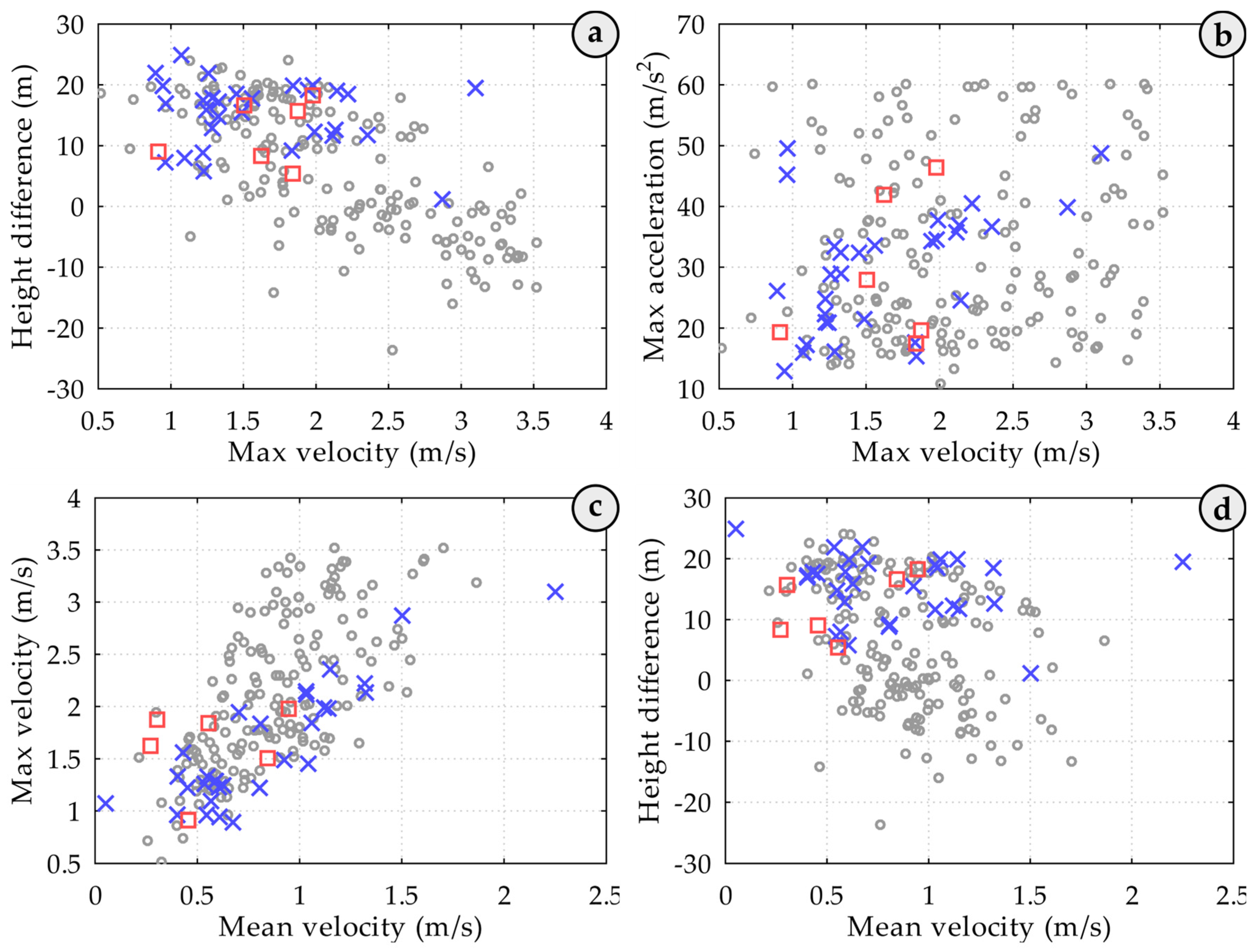
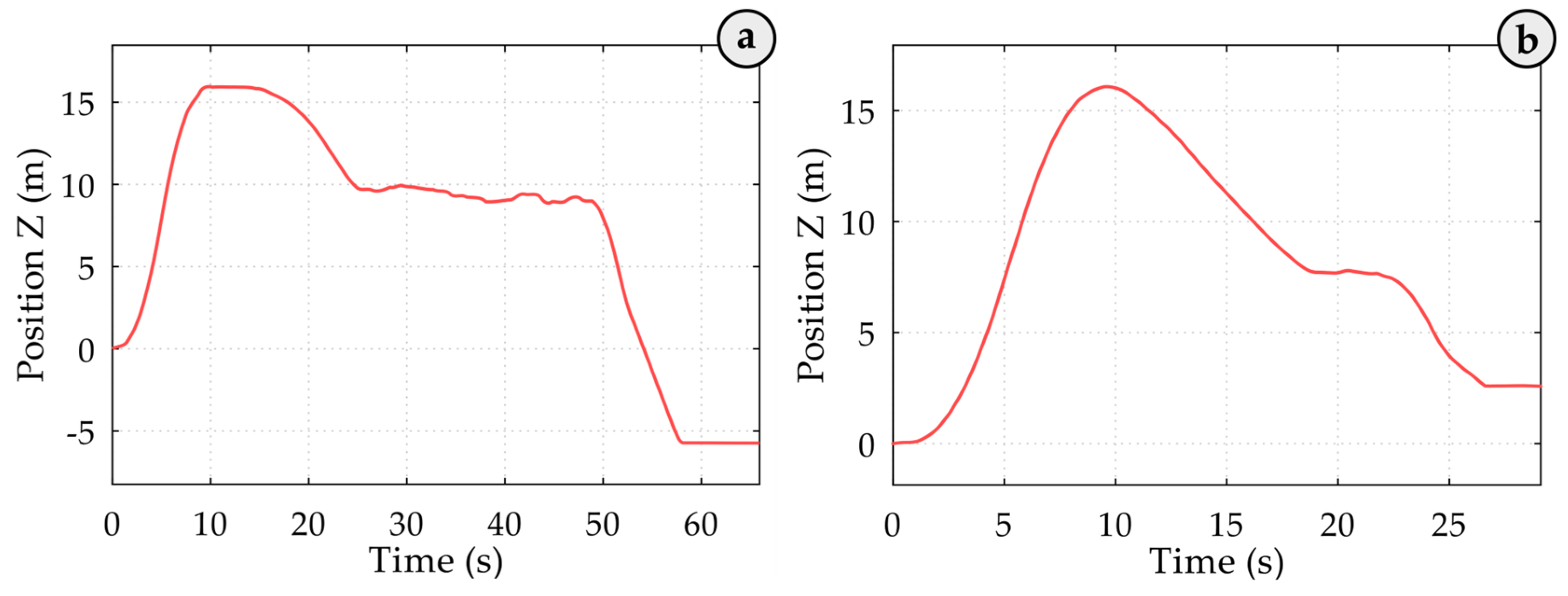

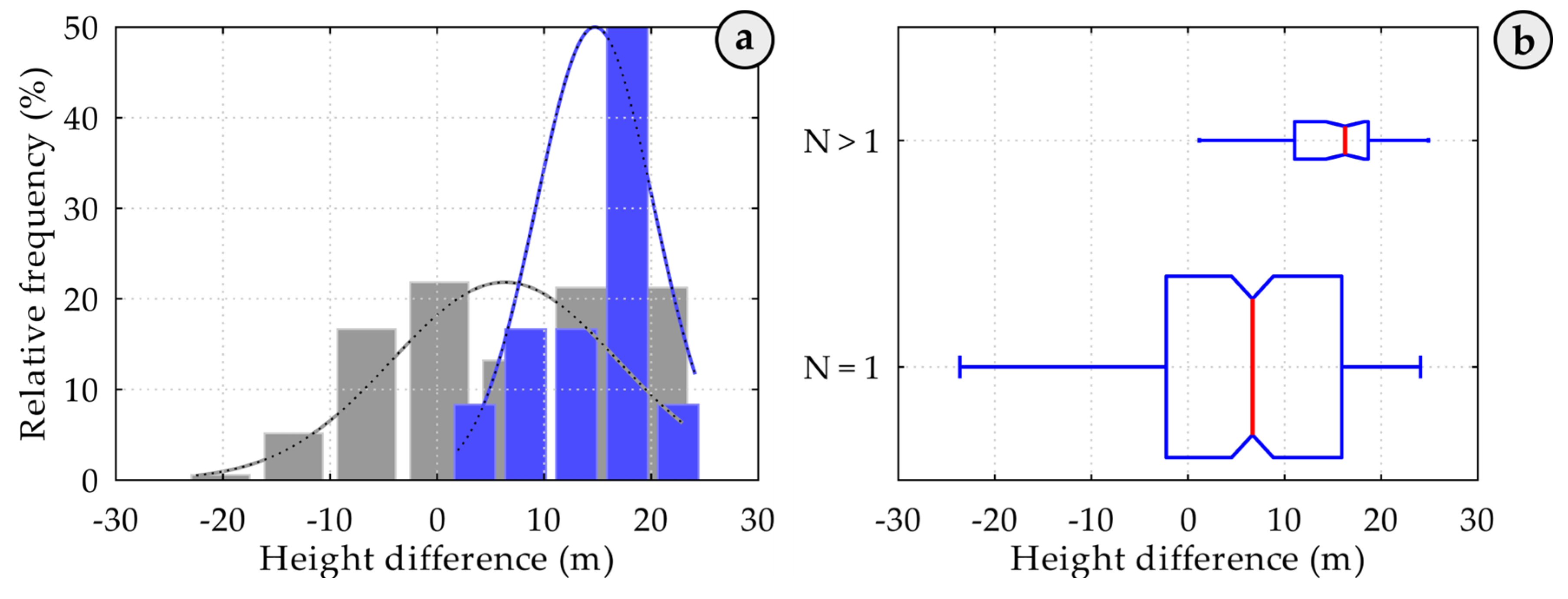
Disclaimer/Publisher’s Note: The statements, opinions and data contained in all publications are solely those of the individual author(s) and contributor(s) and not of MDPI and/or the editor(s). MDPI and/or the editor(s) disclaim responsibility for any injury to people or property resulting from any ideas, methods, instructions or products referred to in the content. |
© 2025 by the authors. Licensee MDPI, Basel, Switzerland. This article is an open access article distributed under the terms and conditions of the Creative Commons Attribution (CC BY) license (https://creativecommons.org/licenses/by/4.0/).
Share and Cite
Jakovlev, S.; Eglynas, T.; Jusis, M.; Jankunas, V.; Voznak, M. Mitigating Container Damage and Enhancing Operational Efficiency in Global Containerisation. Sensors 2025, 25, 2019. https://doi.org/10.3390/s25072019
Jakovlev S, Eglynas T, Jusis M, Jankunas V, Voznak M. Mitigating Container Damage and Enhancing Operational Efficiency in Global Containerisation. Sensors. 2025; 25(7):2019. https://doi.org/10.3390/s25072019
Chicago/Turabian StyleJakovlev, Sergej, Tomas Eglynas, Mindaugas Jusis, Valdas Jankunas, and Miroslav Voznak. 2025. "Mitigating Container Damage and Enhancing Operational Efficiency in Global Containerisation" Sensors 25, no. 7: 2019. https://doi.org/10.3390/s25072019
APA StyleJakovlev, S., Eglynas, T., Jusis, M., Jankunas, V., & Voznak, M. (2025). Mitigating Container Damage and Enhancing Operational Efficiency in Global Containerisation. Sensors, 25(7), 2019. https://doi.org/10.3390/s25072019






